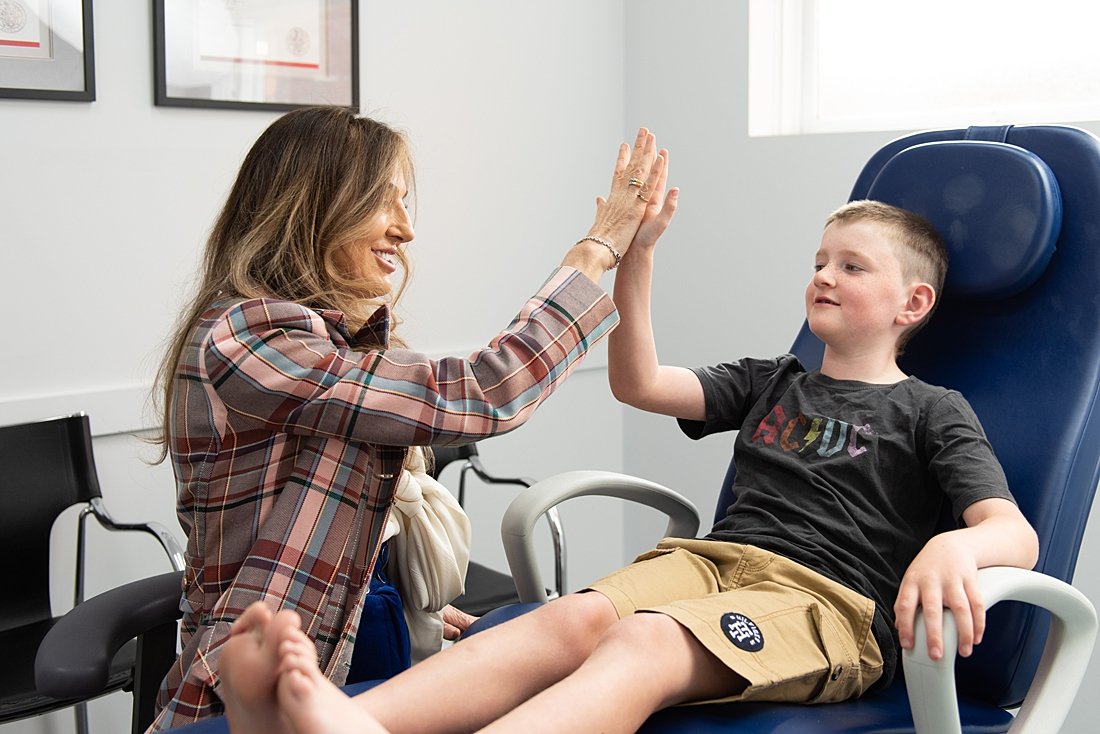PLANTAR WART TREATMENT

WHAT IS A WART?
Warts can appear on various parts of the body and are particularly common on the feet in the form of plantar warts – medically known as verrucas.
A plantar wart is a type of wart that appears on the sole of the foot, usually on the heel or ball of the foot. It is caused by the human papillomavirus (HPV), which enters the body through small breaks in the skin, often on the bottom of the foot. The virus causes the skin cells to grow rapidly, resulting in a small, rough, cauliflower-like growth on the sole of the foot.
CAUSES AND DIAGNOSIS
Warts are contracted through skin-to-skin contact, and so areas such as surfaces around swimming pools and communal changing areas are danger zones when it comes to the spread of the virus. Warts can look similar to corns, however warts contain nerves and have a blood supply, whereas corns don’t.
The risk factors for plantar warts include:
- Weakened immune system: People with weakened immune systems, such as those with HIV or undergoing chemotherapy, are at higher risk of developing plantar warts.
- Age: Children and young adults are more likely to develop plantar warts than older adults.
- Walking barefoot in public places: The virus that causes plantar warts can survive on surfaces such as locker room floors and swimming pool decks.
- Personal contact: Plantar warts can be spread through direct contact with a person who has the virus or by using personal items, such as towels or shoes, that have come into contact with the virus.
- Genetics: Some people may be genetically predisposed to developing warts.
- Previous warts: People who have had plantar warts in the past are more likely to develop them again in the future.
They can be painful due to rubbing and pressure from the location of the wart on the feet. Plantar warts are usually diagnosed through a physical examination of the affected foot by our podiatrists.
The podiatrist will look for characteristic signs of a wart, such as a small, rough, cauliflower-like growth on the sole of the foot that may have black dots or pinprick-sized haemorrhages on its surface. They may also apply pressure to the surrounding area to check for tenderness or pain, which can help distinguish a plantar wart from other foot conditions.
We recommend you seek medical attention if a wart changes shape, colour or causes pain. Always wear protective footwear in communal changing rooms to prevent contracting the virus or spreading the virus to others.
TREATMENT
Not all warts require treatment and in some cases will clear up without treatment, however, it can take up to two years for the virus to leave your system and the warts to disappear.
In adults and people with a weakened immune system, warts are less likely to clear up on their own and often require additional treatment.
There are a number of treatments available for warts, but there is no single treatment that is 100% effective and it may return in time. A wart is a virus, and just like the common cold, the body’s immune system will take care of it in time.
The aim of treatment is to remove the wart without it returning and without leaving any scarring.
Treatments include:
- Salicylic acid or other chemical therapies: Salicylic acid is a common treatment for verrucae, which involves applying a solution of the acid to the affected area. The acid softens the skin and dissolves the wart, which can then be removed with a pumice stone or file. Other chemical therapies may include topical application of other acids or chemicals that break down the wart tissue.
- Cryotherapy (freezing): Cryotherapy involves freezing the wart tissue using liquid nitrogen, which causes the wart to die and fall off. The treatment may require several sessions and can be painful.
- Duct tape therapy: This is a non-invasive treatment for verrucae, which involves applying duct tape to the affected area for several days, then removing it and soaking the area in water. The process is repeated for several weeks until the wart is gone. It is thought that the duct tape creates an environment that is unfavourable to the wart virus.
- Surgical curettage: Surgical curettage involves scraping or cutting the wart tissue with a sharp instrument, such as a scalpel. This is typically done under local anaesthesia, and the area is then covered with a dressing.
- Cantharone: Cantharone is a topical agent that is applied to the wart, causing it to blister. The blistered skin and wart can then be removed, and the area is dressed.
- Vitamin A therapy: Topical application of vitamin A can help to treat verrucae by slowing the growth of the virus and encouraging the growth of healthy skin cells. This treatment can be effective but may require several weeks to see results.
COMPLICATIONS
If left untreated, the warts can spread to other areas of the foot or to other people who come into contact with the virus. The warts can also grow in size and become painful, making it difficult to walk or stand for long periods. Additionally, plantar warts can interfere with the natural alignment of the foot, leading to other foot problems such as flat feet, corns, and calluses.
PREVENTION
By following these prevention tips, you can significantly reduce your risk of developing plantar warts:
- Wear shoes or sandals in public spaces: Avoid walking barefoot in public spaces, especially in damp areas like locker rooms, pools, and showers.
- Practise good foot hygiene: Keep your feet clean and dry, and change your socks and shoes regularly.
- Avoid sharing shoes and socks: Warts can be spread through direct contact, so avoid sharing shoes, socks, or other footwear with others.
- Boost your immune system: A strong immune system can help prevent warts from forming, so eat a healthy diet, exercise regularly, and get enough rest.
- Treat any cuts or scrapes promptly: Plantar warts can enter the body through small breaks in the skin, so it’s important to clean and treat any cuts or scrapes on your feet promptly.
